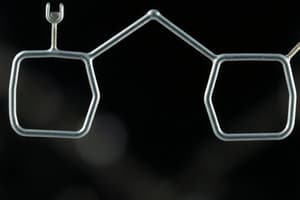Podcast
Questions and Answers
What functional group characterizes aldehydes and ketones?
What functional group characterizes aldehydes and ketones?
- Amine
- Carbonyl (correct)
- Carboxyl
- Hydroxyl
What are aldehydes and ketones named after?
What are aldehydes and ketones named after?
- The parent carbon chain containing the -NH2 group
- The parent carbon chain containing the -C=O group (correct)
- The parent carbon chain containing the -OH group
- The parent carbon chain containing the -CHO group
What can be used to identify the presence of an aldehyde group in a molecule?
What can be used to identify the presence of an aldehyde group in a molecule?
- Fehling's solution
- Tollens' reagent (correct)
- Benedict's solution
- Litmus paper
What is the difference between aldehydes and ketones?
What is the difference between aldehydes and ketones?
What can be used to reduce aldehydes and ketones to alcohols?
What can be used to reduce aldehydes and ketones to alcohols?
What do aldehydes and ketones produce when nucleophilic addition of water occurs?
What do aldehydes and ketones produce when nucleophilic addition of water occurs?
What are acetals?
What are acetals?
What can be used to synthesize ketones?
What can be used to synthesize ketones?
What is the carbonyl group composed of?
What is the carbonyl group composed of?
What are the two general groups that carbonyl compounds can be categorized into?
What are the two general groups that carbonyl compounds can be categorized into?
What is the suffix used to name aldehydes that serve as substituents?
What is the suffix used to name aldehydes that serve as substituents?
What is the prefix used to name ketones that serve as substituents?
What is the prefix used to name ketones that serve as substituents?
What is the product of the nucleophilic addition of water to aldehydes or ketones?
What is the product of the nucleophilic addition of water to aldehydes or ketones?
What is the product of the nucleophilic addition of alcohols to aldehydes or ketones?
What is the product of the nucleophilic addition of alcohols to aldehydes or ketones?
What can Tollens' reagent be used for?
What can Tollens' reagent be used for?
What can be used to reduce aldehydes and ketones to produce alcohols?
What can be used to reduce aldehydes and ketones to produce alcohols?
Flashcards are hidden until you start studying
Study Notes
Aldehydes and Ketones: Nucleophilic Addition Reactions
- Aldehydes and ketones are characterized by the carbonyl functional group and are the most abundant compounds in nature.
- Carbonyl compounds have many industrial applications, including solvents, polymers, and flavorings.
- The carbonyl group consists of a double bond between carbon and oxygen, with carbon being electrophilic and oxygen being nucleophilic.
- Carbonyl compounds can be categorized into two general groups: aldehydes and ketones, and carboxylic acids and their derivatives.
- Aldehydes are named by selecting the parent carbon chain containing the -CHO group and replacing the terminal -e of the corresponding alkane with -al.
- Ketones are named by selecting the parent carbon chain containing the -C=O group and replacing the terminal -e of the corresponding alkane with -one.
- Aldehydes and ketones can also serve as substituents and are named using the suffix -yl or the prefix oxo-.
- Aldehydes can be synthesized by oxidizing primary alcohols, while ketones can be synthesized by oxidizing secondary alcohols or hydrating terminal alkynes.
- Tollens' reagent can be used to identify the presence of an aldehyde group in a molecule.
- Aldehydes and ketones undergo nucleophilic addition reactions, including reduction with NaBH4 or LiAlH4 to produce alcohols.
- Nucleophiles can be negatively charged or neutral and can include water, alcohols, amines, and Grignard reagents.
- Nucleophilic addition of water to aldehydes or ketones yields 1,1-diols, while addition of alcohols produces acetals. Acetals can serve as protecting groups for aldehydes and ketones.
Studying That Suits You
Use AI to generate personalized quizzes and flashcards to suit your learning preferences.





